[ad_1]
Listen to this story:
Tbilisi, Georgia – Sitting in the corner of a Ukrainian-run café in downtown Tbilisi, Alla Timoshenko deftly runs a threaded needle through a bird-shaped piece of felt.
For Ukrainians, the nightingale that she is embroidering to turn into a brooch is a symbol of hope, spring and building homes, Alla explains.
Once complete, she plans to sell the item through her Instagram handle as an emblem of hope for Ukraine’s victory against Russia.
Embroidery has always been a form of creative expression for Alla, whose grandmother taught her the craft when she was eight years old. But it was only ever a hobby for her until her late twenties when she decided to quit her stressful job with an IT company in Kyiv and become a design consultant. “Embroidery became a form of meditation for me,” says the 34-year-old, who started using the skill professionally.
She has worked on commissioned embroidery art projects for hotels and cafes – such as the one where she now sits – both in her native Ukraine and in Georgia, where she has lived on and off since 2017. But after February 24, 2022, when Russia launched its full-scale invasion of Ukraine, embroidery became an outlet for Alla’s grief and rage.
‘A protective amulet’
When the war began, Alla was in Tbilisi and could only fervently follow the news headlines and speak to her parents back in Ukraine. Her parents assured her they were safe in their hometown of Pyryatyn in the central region of Poltava. “They were more calm than me,” admits Alla, who felt despondent and anxious for weeks.
“I told myself this isn’t the time for embroidery,” she says. “But then I soon realised I had to do everything I could for my country and use my talents and creative energy to help.”
So she started embroidering as a way to express her support for her country.
On the 28th day of the war, she posted an embellished jacket she had just completed to Instagram, saying embroidery was her way of “contributing Ukrainian talents to the future”.
She then started working on embroidered brooches in her country’s national colours of blue and yellow, tapping into imagery that has long been a part of Ukrainian folk tales, poems and cultural identity. Alla has made brooches depicting nightingales, sunflowers, dandelions and the Ukrainian coat of arms, the tryzub, and also embroidered T-shirts and jackets, selling everything via Instagram. Half of the proceeds from her sales now go to Ukrainian volunteers working to evacuate and provide aid to refugees.
Writing in English and Ukrainian on Instagram, Alla explains the cultural symbolism and folk beliefs behind each embroidered motif, such as signifying good luck or protection.
One T-shirt carries an excerpt from a poem by Lesya Ukrainka, a 19th-century dissident poet and activist who wrote in Ukrainian even though it was banned at the time in the Russian Empire. “My heart burns up in a rage of fire, consumed within a flame of bitter grief,” read the lines embroidered in blue thread.
“These lines perfectly summed up my emotions about the invasion,” says Alla of the fragment which she embellished with one of her favourite spring blossoms – a malva flower.
Although it is a T-shirt it qualifies as a vyshyvanka – meaning “embroidered shirt” in Ukrainian – according to Alla.
“For us, a traditional vyshyvanka is a protective amulet full of symbolism,” she says, explaining that her designs are like a “personal talisman” carrying some of her story, thoughts and wishes.
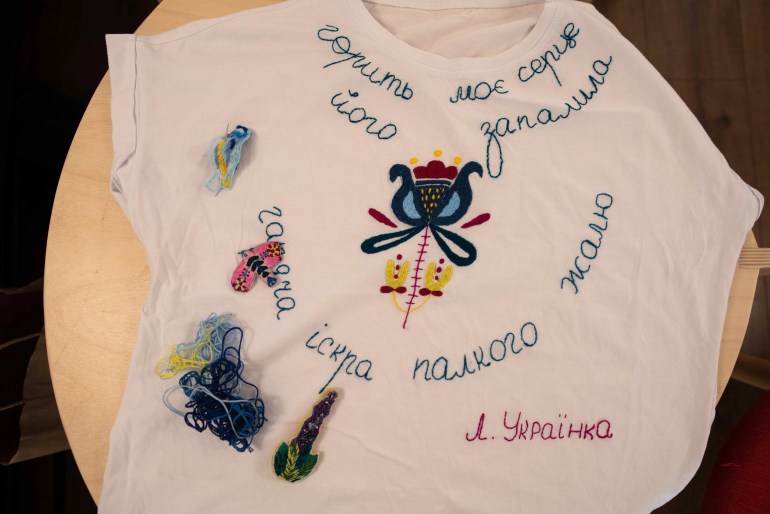
Symbolic motifs
For Ukrainians, embroidery signifies something much deeper than a cultural art form and is typified in the vyshyvanka, which has motifs running along the neck, chest, cuffs and sleeves.
Embroidery patterns and needlework techniques abound in Ukraine, with each region identifiable through its own unique symbolic patterns, motifs and colour codes. There are about 200 different documented stitches and ornamental styles in Ukraine.
The history of embroidery in Ukraine can be traced as far back as the Scythians, an ancient nomadic group that dominated the Eurasian Steppe from present-day Iran to Mongolia between the 7th and 3rd centuries BC, and settled in large groups in what became modern-day Ukraine.
Although embroidery is found globally, it took on particular cultural significance in Ukraine where it has long been the most widespread decorative art.
Cossacks who ruled parts of independent Ukraine in the 16th and 17th centuries believed the embroidery patterns on their shirts protected them in battle and gave them strength.
Geometric patterns like the square to denote the earth, the rhombus for fertility, circles for the sun, triangles for eternal life and chevrons to represent femininity, masculinity, and spirituality were common motifs, along with zoomorphic and nature-inspired patterns.
Elaborate floral patterns in gold and silver thread became highly popular among the Ukrainian Cossack elite, which held power until they were crushed by the Russian Empire. Apart from the attire of peasants, soldiers and the elite, rushnyks or hand towels featuring elaborate red thread embroidery on white linen, were made and given as presents to mark all the important milestones of life – from births and baptisms to weddings and funerals.
“Every Ukrainian grew up surrounded by these old family heirlooms whether it’s a vyshyvanka or a rushnyk or a tablecloth that was embroidered by a grandmother or great-grandmother,” explains Alla.
She creates her own patterns and uses needlework techniques like the satin stitch rather than the cross stitch that her grandmother insisted she learn. Cross-stitch techniques introduced from western Europe in the 19th century replaced many of the more labour-intensive approaches founds in Ukrainian embroidery.
When Alla’s parents offered to send a parcel from home through a friend who was leaving Ukraine, she could only think of one thing – an old family tablecloth with crocheted seams adorned with cross-stitched roses and purple spring flowers that her grandmother had made as a 15-year-old. “I realised this was the most precious thing for me to remember home because this is a piece of family history,” she says.
Now, Alla has started learning older, more complex Ukrainian embroidery techniques, like a white-on-white open work approach called reshetylivka which her home region of Poltava is famous for. “I see this as a way of preserving a part of my culture and identity that’s under attack,” she explains.
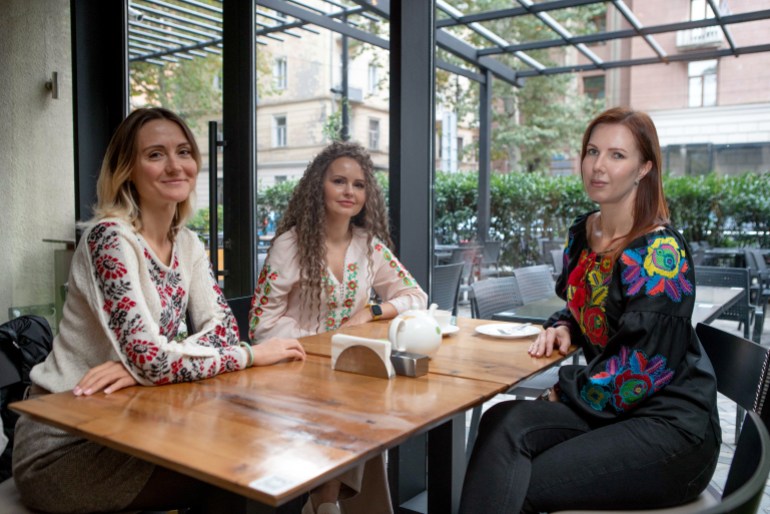
Popularising an icon
In a Tbilisi café serving American and Asian fare, Marina Romashko recounts how she fled the central Ukrainian city of Dnipro when it faced a barrage of missile attacks in March 2022. Before leaving her apartment, the 38-year-old hastily shoved a machine-knit vyshyvanka along with a hand-embroidered one made by a favourite aunt into her backpack.
“I just felt I had to take something that somehow shows my Ukrainian identity and reminds me of home,” says Marina, who came to Georgia when a friend offered to house her and her 19-year-old daughter. The women are among the estimated nearly eight million Ukrainian refugees who have fled the country.
The former tour guide and operator sits with Katerina Ustinova, 37, and Valeriya Sokolenko, 34, who Marina befriended soon after arriving in the Georgian capital. The two women, originally from Dnipro, moved to Georgia before the war and had been helping newly arrived refugees.
In the summer, Katerina started importing machine-embroidered vyshyvankas made by her sister-in-law in Ukraine and selling them in Tbilisi to raise funds for the armed forces. Marina and Valeriya quickly joined the initiative, called Vyshyvanka_In_Tbilisi, helping to market the shirts through social media platforms.
For Katerina, the project is about supporting her sister-in-law who donates all her profits to buy military equipment for the army. But it is also about popularising an icon of Ukrainian culture.
As the conflict drags on, the project is one way they hope to keep Ukraine in focus. “If people only associated Ukraine with Chornobyl and Andriy Shevchenko [a former professional footballer] before, I hope that after this war they will at least know what a vyshyvanka is,” jokes Marina.
The three women have started adding more vyshyvankas and Ukrainian elements to their wardrobes to stand out from the recently arrived Russians. With an estimated 100,000 arrivals since March, Russian exiles far outnumber the estimated 30,000 Ukrainians who moved to Georgia after the war broke out.
The women, who are originally from a city where Russian is widely spoken, also make a point of speaking to one other in Ukrainian, especially when in public.
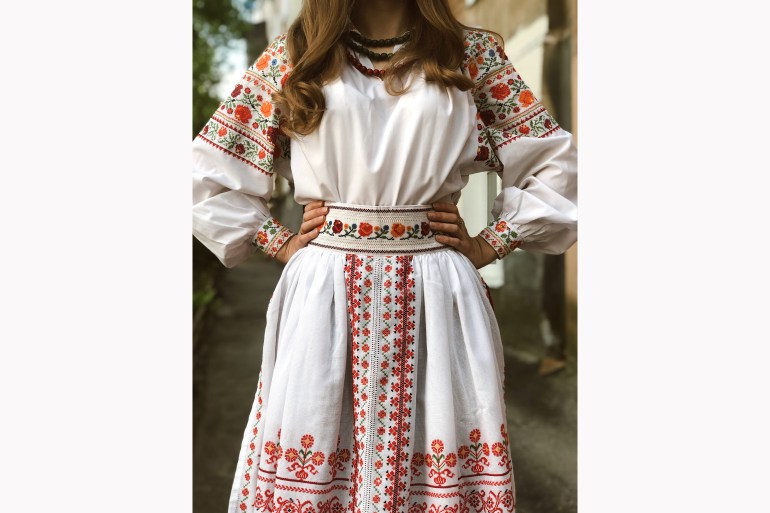
A symbol of independence
Like many aspects of Ukrainian culture, literature and language that were suppressed by the Russian Empire and by the authoritarian Soviet rule that followed, vyshyvankas were once stripped of their symbolism and reduced to sartorial kitsch. Shiny red satin pants and skirts became the norm to represent Cossack attire during state-endorsed festivals held to celebrate the Soviet Union’s diversity, recounts Valeriya.
Ukrainians even have a term – sharovarshchyna – that refers to the crude Russian portrayals of their culture and Cossack heritage during the Soviet period. “It’s only recently that many Ukrainians started to proudly wear their vyshyvankas and we even have a special day for it now,” adds Valeriya.
World Vyshyvanka Day started in 2006 after a group of students at the Chernivtsi National University organised a flash mob and the entire university turned up in vyshyvankas. Today, it is celebrated every third Thursday in May with people across the country wearing vyshyvankas.
Last year, political dignitaries, including European Commission president Ursula von der Leyen, Lithuanian prime minister Ingrida Simonyte and Canada’s Justin Trudeau, donned vyshyvankas as a mark of solidarity with Ukraine. The shirt worn for the occasion by Ukrainian President Volodymyr Zelenskyy was auctioned in June for $100,000 in Washington, DC, to raise funds for aid and weapons.
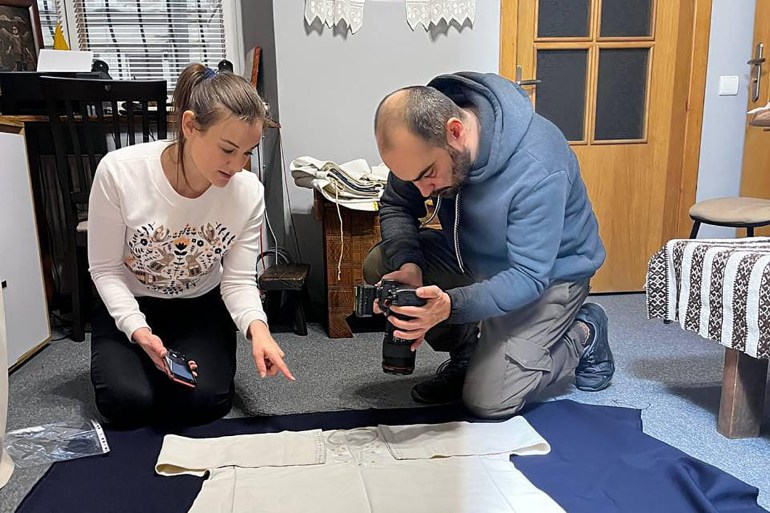
“The vyshyvanka is not only a traditional part of the Ukrainian wardrobe but a national symbol of the struggle for independence, a symbol of [our] spirit [of] invincibility and a symbol of hope and love,” says Kyiv-based Lesia Voroniuk, one of the organisers of the original flash mob, writing over email. Due to attacks on the power grid that have left much of Ukraine without light or heating during hours-long power cuts, Lesia apologises for the weeks it has taken her to respond to emails.
Lesia and her colleagues registered World Vyshyvanka Day in 2015 as a non-profit dedicated to safeguarding the folk art and culture around the vyshyvanka craft. Since the outbreak of the war, they have worked to rescue embroidery artefacts and vyshyvankas from areas with fighting – both from private collections and local museums. In November an expedition to collect Ukrainian state symbols, including the tryzub and blue and yellow thread-based textiles embroidered in secret during the Soviet occupation, saw the organisation travel to seven towns under bombardment.
“The ongoing war is a war of identities and values. Ukrainians are forced to confront cave people – Russian soldiers,” asserts Lesia, who sees saving these textiles as an act of resistance.
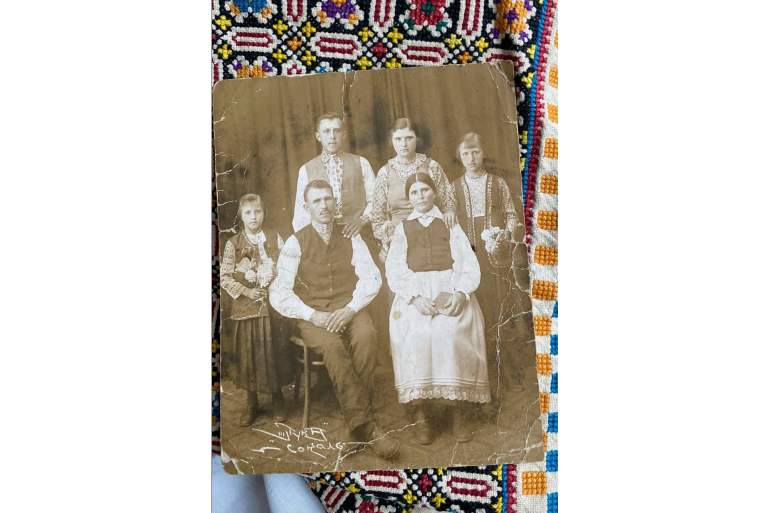
‘Feel this support’
While the race is on to save cultural artefacts, others working with embroidery are finding different ways to resist Russia.
Andriy Cherukha, 32, founded his clothing label Etnodim when he was 18. He has spent years researching traditional patterns which he applies – along with imagery from old photographs and illustrations – to contemporary clothing designs.
A recent shirt design, for example, is a nod to a 16th-century parable about a hermit and bird in search of truth and recreates illustrations collected by contemporary literary critic Leonid Ushkalov. “We are creating an archive of national values,” he says.
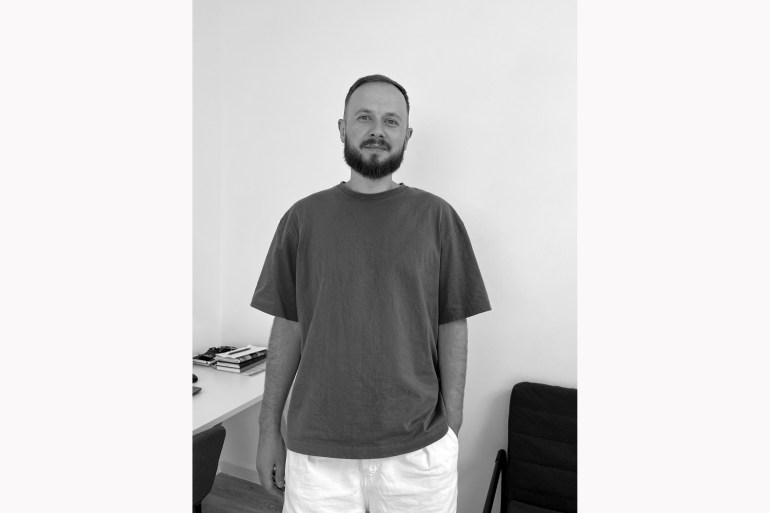
At the onset of the war, the brand had to halt production in Kyiv. Andriy decided to relocate to the relative safety of Lviv in the country’s west despite the logistical hurdles. “We, as a business, have a responsibility to our country. We must support the economy of Ukraine,” says Andriy, whose company donates a portion of its sales to the armed forces.
Global solidarity for Ukraine gave a surprising boost to business as international demand exponentially increased in the months following the invasion, with about 70 percent of the orders coming from countries like Poland, Lithuania, Estonia and the US, says Andriy. “It’s really important for us today, and not only for business. We still feel this support, the world hasn’t abandoned us,” he says.
The brand is currently working on new designs dedicated to Ukrainian artists, activists and writers executed during Soviet rule. Meanwhile, the label recently teamed up with well-known Ukrainian poet Sergiy Zhadan for a social media campaign that aimed to raise funds to buy 100 vehicles for the armed forces.
Andriy is convinced that the collective solidarity of Ukrainians fighting for the right to exist is what will eventually bring victory. “We are two different nations, and we’ll do everything to keep a stone wall between us forever,” he says.
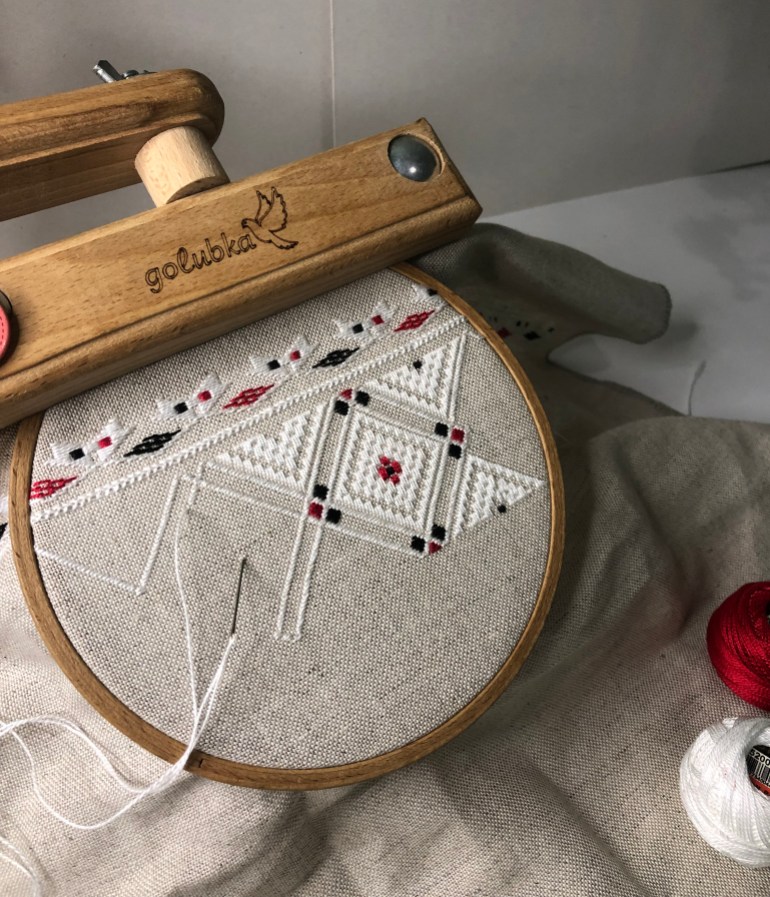
Time to show the ‘real Ukraine’
Nearly a year into the conflict, many Ukrainians believe the war has united Ukrainians and solidified a sense of identity. “Due to years of Russian influence, foreigners had a distorted idea of Ukrainian culture, customs and our national clothes too. But now more than ever is the right time to show the real Ukraine,” says Maryana Lyba, 24, an embroidery artist based in Lviv. She is referring to how foreigners have at times conflated Ukrainians with Russians in areas such as language and culture.
Her first project at age 16 was to replicate the perfectly symmetrical lines of flower motifs of the western Yavoriv region where her mother is from. And following tradition, she hand-embroidered her own wedding vyshyvanka and that of her husband in the classic style from Borshchiv – a region southwest of Kyiv – that features black wool threads.
After becoming a mother two years ago, Maryana launched her own embroidery studio called Golubka through which she accepts commissioned orders. When the war started, she almost gave up on her business until her first international requests started coming in from Ukrainians living abroad as well as from foreigners seeking to support Ukrainian businesses.
Amid the air raid sirens, power cuts and lack of heating, it is a daily struggle to care for her young child. But she still finds time to complete special orders for vyshyvankas while learning old embroidery techniques central to making these blouses.
She has recreated a vyshyvanka from an old black and white photo of Stepan Bandera – a controversial Ukrainian freedom fighter who collaborated with the Germans during the second world war to try and wrangle independence for Ukraine. Her current project is recreating a century-old pattern from the region of Chernihiv on natural hemp cloth for a US-based Ukrainian client. Each hand-embroidered vyshyvanka takes about a month and a half to complete and Maryana donates 30 percent of her proceeds to the Ukrainian armed forces.
Maryana hopes for the war to end soon and for the continued revival and support for Ukraine’s traditional embroidery. She says she’s glad that Ukrainian artisans have started to revive “old [stitch] techniques like verhoplut, nizinka and lishtva in their work. I hope to make my modest contribution to this cause too,” she says.
Back in Tbilisi, Valeriya, Katerina and Marina have been busy with various fairs across the city over the Christmas period. “Thanks to Katerina, almost every Ukrainian here now has a vyshyvanka to wear even if they couldn’t bring theirs from home,” says Valeriya.
Support for the business is growing – and it’s not just from Ukrainians. “Many of our Georgian friends who bought our vyshyvankas tell us they’re saving them to wear for our victory day,” says Katerina with a laugh.
[ad_2]
Source link